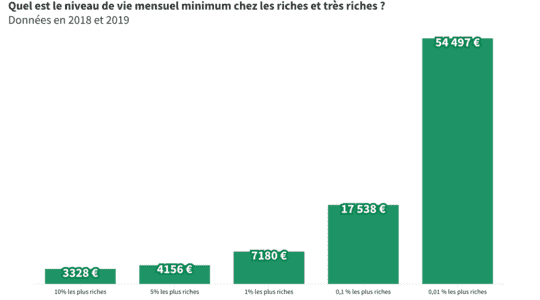The report of the Observatory of inequalities, published Wednesday, June 1, seizes the question of wealth, a concept often diffuse in our minds. This work aims to answer the following questions: what is it to be rich? How many French people are considered “rich”? Are the rich getting richer and richer?
In the second edition of his “report on the rich in France“, which aims to fuel an “informed debate” on this subject, the Observatory of Inequalities begins by defining a “wealth threshold”, in the same way that INSEE defines a “poverty threshold”. at twice the median income – i.e. 3,673 euros per month for a single person, taxes deducted, or 7,713 euros for a couple with two children – 4.5 million French people are rich, i.e. 7.1% of the population , detail the authors of the report, Anne Brunner and Louis Maurin.
To view the graph, click here.
With this definition in mind, let’s take a look at the trend: the share of French people who can be considered “rich” fell from 8.6% to 7.1% between 2010 and 2019 – 745,000 fewer people are above our wealth threshold. This does not mean that the wealthiest have become poorer but that inequalities have fallen slightly, according to calculations published Wednesday by an independent body. The decline in the proportion of rich households between 2010 and 2019 is explained in particular by the tax measures decided in 2011 and 2012, which affected high incomes, and by the measures in favor of the middle classes decided in 2019 to respond to the anger yellow vests.
The rich getting richer
Despite everything, the rich are “significantly richer than 20 years ago”, observed Louis Maurin. Between 1999 and 2019, the average annual standard of living of the wealthiest 10%, adjusted for inflation, increased by 9,100 euros, compared to 3,300 euros for the middle classes. While the standard of living of the richest 10% had fallen between 2011 and 2013, it rose again in 2018 under the effect of the tax reforms ofEmmanuel Macron which were favorable to them. Note that the richest 10% receive 28% of all income, before taxes.
To view the graph, click here.
Members of the club of top 1% remain the big winners of these measures, which increase their after-tax income by nearly 3%. If we focus on these “ultra-rich” – whose minimum standard of living is 7180 euros per month – the trend is towards enrichment. The 1% of the highest salaries in the private sector continues to rise. “As for the 500 greatest professional fortunes, their value has quadrupled in ten years,” adds the Observatory of Inequalities.
To view the graph, click here.
Based on data provided by Eurostat, the Inequality Observatory ranks countries according to the minimum monthly standard of living to belong to the richest 1% caste. France comes in fourth place. On the podium: Switzerland (8,802 euros), Germany (7,194 euros) and Norway (6,562). It should be noted that Switzerland represents a particular case, since it concentrates a quantity of financial wealth. In the poorest European countries, such as Romania and Slovakia, the thresholds for the richest 1% are around 2,000 euros.
To view the graph, click here.
28% of the richest individuals live in Ile-de-France
In addition, wealth can take several forms, such as heritage: “4.5 million households have more than three times the median wealth, our threshold of wealth in terms of heritage, that is to say more than 490,000 euros “, estimates the Observatory of inequalities. We also learn that 16% of French households exceed this wealth threshold and 4% of households are millionaires. For the wealthiest 10%, their minimum assets amount to 607,700 euros. For the richest 1%, the figure rises to 1,914,600. In addition, 82% of the richest people own their homes. Also, the wealthiest 10% have 46% of the wealth of all households.
To view the graph, click here.
Finally, the study paints a composite portrait of wealthy people in France. Their average age is 57 years old. Geographically, 16% of the richest individuals live in Paris or in the Hauts-de-Seine. In total, 28% live in Ile-de-France. Regarding their job: 68% of wealthy working households are senior executives, in the liberal professions, craftsmen, traders or business leaders.
But the French are not all equal in terms of heritage, since the share of inheritance has increased in recent years. The Inequalities Observatory is based on the work of Thomas Piketty, Capital in the 21st century (Threshold 2013) which declares that 67% of private capital in 2010 comes from inheritance. Not surprisingly, wealth is something that is passed on.
